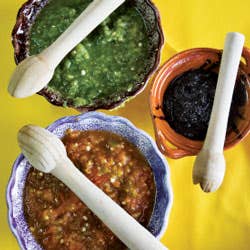
Mexico City: North America’s New Food Capital
Many big cities in the developing world—with their clogged streets, frenetic pace, and pockets of opulence amid poverty—trigger in visitors a heady combination of wariness, curiosity, and exhilaration. But no other city we know saturates the senses more completely, or delivers more dizzying extremes of refinement and grit—often on the very same block—than Mexico City.
Before anything else, there are the aromas of the place, especially those coming from street-food stalls, with their mesquite charcoal fires fueling pots of epazote-flavored black beans and griddles lined with quesadillas. And then there are the fragrances of the foods themselves, most prominently that of the lime juice and skin that appears in countless dishes, from guacamoles and soups to ceviches and salsas.
The aromas keep pulling us back to the centrally located and gargantuan Mercado de la Merced, said to have been built on the site of a vegetable market from Aztec times. Passing through the crowded aisles dedicated to dried chiles—some stalls offer as many as 25 varieties, each possessing its own, unique flavor—you inhale their intense perfume. Farther on, you're met with the scent of lush banana leaves and parchment-like agave skins. After that come fruit vendors selling guavas, zapotes, and guanabanas that smell of the jungles where they were picked.
Nearby, bold new cuisines are flourishing. At his chic restaurant Pujol, in the Polanco neighborhood, chef Enrique Olvera, a Culinary Institute of America graduate, takes the street-food classic called esquites (corn with mayonnaise and lime) and turns it into a refined braise: three varieties of corn layered with delicate queso fresco and pequin chiles, all topped with a mayonnaise gelatin that melts luxuriously as the waiter pours on the warm braising juices. Paired with a rose from Baja's stellar Adobe Guadalupe winery, the dish really soars.
Somewhere in the middle of the vast continuum of the city's food culture lies the classic cuisine of mid-20th-century Mexico, found in the colonial-style dining rooms of stalwarts like the 52-year-old Fonda el Refugio, in the city's Zona Rosa, or Restaurante Carnitas El Bajio, for our money the best traditional restaurant in the city. There, owner Carmen Ramirez Degollado keeps the tipico decor as fresh and colorful as it was the day the place opened. The straightforward fare—carnitas (braised or roasted pork), Central Mexican-style moles, and the soupy huatapes and black bean gorditas of Carmen's hometown of Jalapa—is executed with care and balance.
Such staid dining notwithstanding, residents of Mexico City know how to enjoy a big party. Every weekend at Restaurante Arroyo, thousands of families feast on agave-wrapped, pit-cooked lamb with black pasilla chile salsa, crunchy chicharron, and guacamole. It's the opposite of an intimate restaurant—the place seats a couple of hundred people, and mariachis perform in each dining room—and yet the service is utterly efficient, the result of decades of practice.
Like all great metropolises, Mexico City pulses with life deep into the night. Revelers in need of sustenance flock to the Charco de las Ranas, a taqueria on a grand scale, open 24-7. Amid its big-top decor, you can settle into a plate of flame-roasted pork tacos al pastor, served with roasted pineapple on handmade tortillas, or simply imbibe a nice, frothy glass of horchata—a sweet, cinnamon-scented rice-based drink—while you take in the capital city's great urban pageant.
Keep Reading
Continue to Next Story










